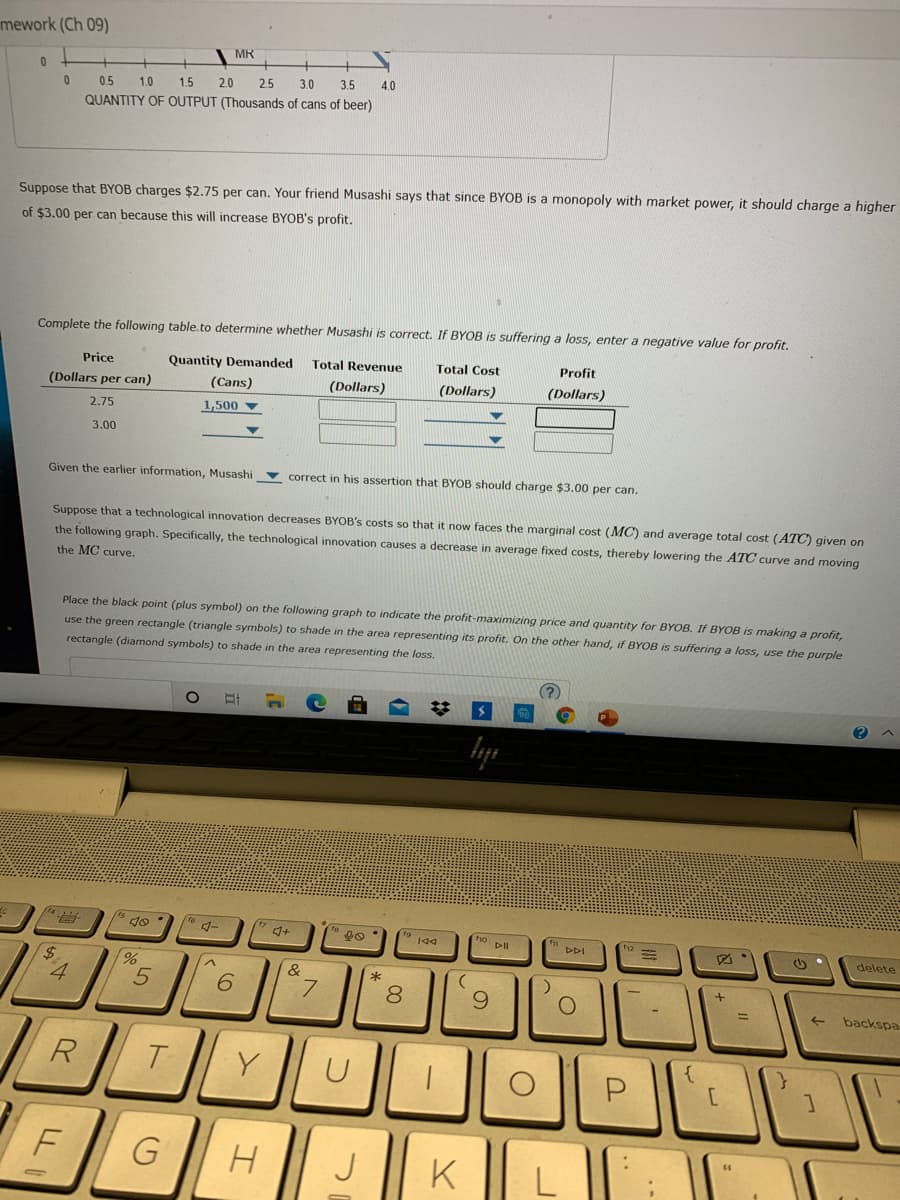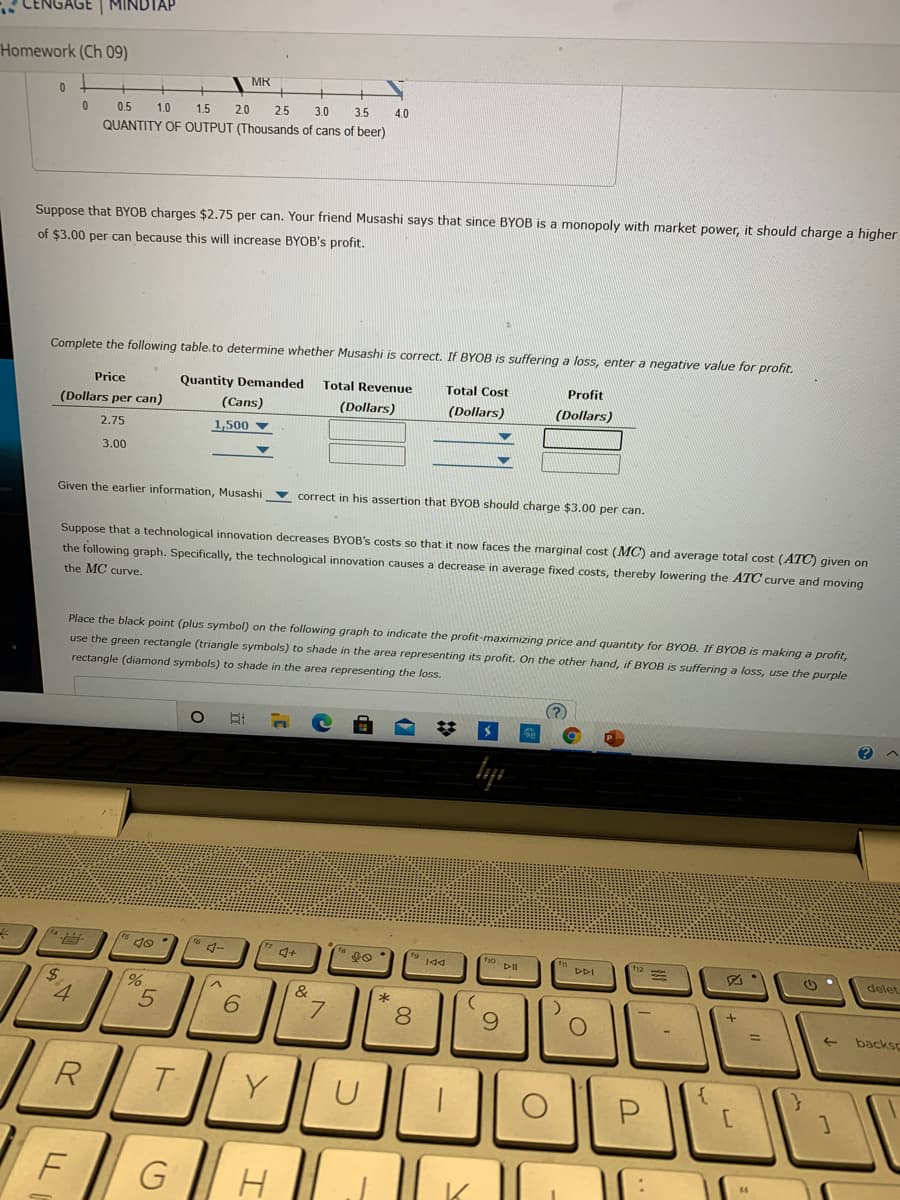1.5 2.0 2.5 3.0 3.5 4.0 QUANTITY OF OUTPUT (Thousands of cans of beer) that BYOB charges $2.75 per can. Your friend Musashi says that since BYOB is a monopoly with market power, it should charge a high per can because this will increase BYOB's profit. lete the following table.to determine whether Musashi is correct. If BYOB is suffering a loss, enter a negative value for profit. Price Quantity Demanded Total Revenue Total Cost Profit llars per can) (Cans) (Dollars) (Dollars) (Dollars) 2.75 1,500 3.00 en the earlier information, Musashi correct in his assertion that BYOB should charge $3.00 per can. ppose that a technological innovation decreases BYOB's costs so that it now faces the marginal cost (MC) and average total cost (ATC) given on e following graph. Specifically, the technological innovation causes a decrease in average fixed costs, thereby lowering the ATC curve and moving e MC curve. lace the black point (plus symbol) on the following graph to indicate the profit-maximizing price and quantity for BYOB. If BYOB is making a profit, se the green rectangle (triangle symbols) to shade in the area representing its profit. On the other hand, if BYOB is suffering a loss, use the purple rectangle (diamond symbols) to shade in the area representing the loss.
1.5 2.0 2.5 3.0 3.5 4.0 QUANTITY OF OUTPUT (Thousands of cans of beer) that BYOB charges $2.75 per can. Your friend Musashi says that since BYOB is a monopoly with market power, it should charge a high per can because this will increase BYOB's profit. lete the following table.to determine whether Musashi is correct. If BYOB is suffering a loss, enter a negative value for profit. Price Quantity Demanded Total Revenue Total Cost Profit llars per can) (Cans) (Dollars) (Dollars) (Dollars) 2.75 1,500 3.00 en the earlier information, Musashi correct in his assertion that BYOB should charge $3.00 per can. ppose that a technological innovation decreases BYOB's costs so that it now faces the marginal cost (MC) and average total cost (ATC) given on e following graph. Specifically, the technological innovation causes a decrease in average fixed costs, thereby lowering the ATC curve and moving e MC curve. lace the black point (plus symbol) on the following graph to indicate the profit-maximizing price and quantity for BYOB. If BYOB is making a profit, se the green rectangle (triangle symbols) to shade in the area representing its profit. On the other hand, if BYOB is suffering a loss, use the purple rectangle (diamond symbols) to shade in the area representing the loss.
Essentials of Economics (MindTap Course List)
8th Edition
ISBN:9781337091992
Author:N. Gregory Mankiw
Publisher:N. Gregory Mankiw
Chapter14: Monopoly
Section: Chapter Questions
Problem 9PA
Related questions
Question
Not sure how to complete the chart

Transcribed Image Text:mework (Ch 09)
MR
0.5
1.0
1.5
2.0
2.5
3.0
3.5
4.0
QUANTITY OF OUTPUT (Thousands of cans of beer)
Suppose that BYOB charges $2.75 per can. Your friend Musashi says that since BYOB is a monopoly with market power, it should charge a higher
of $3.00 per can because this will increase BYOB's profit.
Complete the following table.to determine whether Musashi is correct. If BYOB is suffering a loss, enter a negative value for profit.
Price
Quantity Demanded
Total Revenue
Total Cost
Profit
(Dollars per can)
(Cans)
(Dollars)
(Dollars)
(Dollars)
2.75
1,500 v
3.00
Given the earlier information, Musashi
v correct in his assertion that BYOB should charge $3.00 per can.
Suppose that a technological innovation decreases BYOB's costs so that it now faces the marginal cost (MC) and average total cost (ATC) given on
the following graph. Specifically, the technological innovation causes a decrease in average fixed costs, thereby lowering the ATC curve and moving
the MC curve.
Place the black point (plus symbol) on the following graph to indicate the profit-maximizing price and quantity for BYOB. If BYOB is making a profit,
use the green rectangle (triangle symbols) to shade in the area representing its profit. On the other hand, if BYOB is suffering a loss, use the purple
rectangle (diamond symbols) to shade in the area representing the loss.
do
4-
delete
&
4
6.
7.
*
8.
6.
backspa
POL
R
T.
Y
J
K

Transcribed Image Text:CENGAGE | MINDTAP
Homework (Ch 09)
MR
0.5
1.0
1.5
2.0
25
30
3.5
4.0
QUANTITY OF OUTPUT (Thousands of cans of beer)
Suppose that BYOB charges $2.75 per can. Your friend Musashi says that since BYOB is a monopoly with market power, it should charge a higher
of $3.00 per can because this will increase BYOB's profit.
Complete the following table.to determine whether Musashi is correct. If BYOB is suffering a loss, enter a negative value for profit.
Price
Quantity Demanded
Total Revenue
Total Cost
Profit
(Dollars per can)
(Cans)
(Dollars)
(Dollars)
(Dollars)
2.75
1,500 v
3.00
Given the earlier information, Musashi
v correct in his assertion that BYOB should charge $3.00 per can.
Suppose that a technological innovation decreases BYOB's costs so that it now faces the marginal cost (MC) and average total cost (ATC) given on
the following graph. Specifically, the technological innovation causes a decrease in average fixed costs, thereby lowering the ATC curve and moving
the MC curve.
Place the black point (plus symbol) on the following graph to indicate the profit-maximizing price and quantity for BYOB. If BYOB is making a profit,
use the green rectangle (triangle symbols) to shade in the area representing its profit. On the other hand, if BYOB is suffering a loss, use the purple
rectangle (diamond symbols) to shade in the area representing the loss.
4-
144
DDI
delet
2$
%
&
*
6.
7.
8.
backsc
R
Y
U
LL
Expert Solution
This question has been solved!
Explore an expertly crafted, step-by-step solution for a thorough understanding of key concepts.
This is a popular solution!
Trending now
This is a popular solution!
Step by step
Solved in 3 steps with 2 images

Knowledge Booster
Learn more about
Need a deep-dive on the concept behind this application? Look no further. Learn more about this topic, economics and related others by exploring similar questions and additional content below.Recommended textbooks for you

Essentials of Economics (MindTap Course List)
Economics
ISBN:
9781337091992
Author:
N. Gregory Mankiw
Publisher:
Cengage Learning


Principles of Economics 2e
Economics
ISBN:
9781947172364
Author:
Steven A. Greenlaw; David Shapiro
Publisher:
OpenStax

Essentials of Economics (MindTap Course List)
Economics
ISBN:
9781337091992
Author:
N. Gregory Mankiw
Publisher:
Cengage Learning


Principles of Economics 2e
Economics
ISBN:
9781947172364
Author:
Steven A. Greenlaw; David Shapiro
Publisher:
OpenStax

Exploring Economics
Economics
ISBN:
9781544336329
Author:
Robert L. Sexton
Publisher:
SAGE Publications, Inc

